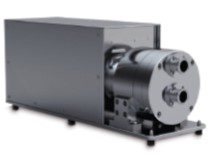Case Study: QF4400- NPSHr of a Self-Priming Pump

Quattroflow QF400 Pump
For our first post of 2017, we will be talking about a few issues and from one of most successful products in 2016- the Quattroflow quaternary diaphragm pump. Today’s post will talk about NPSHA, self-priming pumps, and a specific application troubleshooting a QF4400.
Let’s start by taking a look at a problem a client of ours had recently during startup of a QF4400. If you’ve been reading our blog, you’ll know that one of the hallmark characteristics of the Quattroflow line of pumps is their ability to actually pump air and create considerable suction lift. The Quattroflow QF4400, for instance, can generate up to 4.5 meters of suction lift! Just because the pump can generate suction lift, however, doesn’t mean you can’t still see (or hear) cavitation at the inlet of the pump. It is important to remember the NPSH stands for net POSITIVE suction head. You can’t have a “negative” suction head.Thus, every pump will have SOME net positive suction head required. If at any time the pressure at the inlet of the pump drops below the vapor pressure of the fluid being pumped, you will see and hear the pump cavitate, resulting in noisy operation and erratic flow.
This is precisely what happened during a recent FAT. A client was commissioning a skid that used a Quattroflow QF4400 as a supply pump. During the FAT, the skid was connected via hoses to some water tanks about 10’ away from the skid. The water flowed from the tanks, up about 5 feet and then down through an elbow and into the QF4400 bottom inlet. While hardly ideal suction conditions, the Quattroflow was able to evacuate air from the line and draw product to the inlet. Once sufficient speed was reached, however, a noticeable chatter could be heard at the pump.
What was happening? Simple- cavitation. To understand why this was occurring, let us consider how the all Quattroflow pumps move fluid. A Quattroflow pump uses an eccentric disc to nutate the four pump diaphragms. When the diaphragms retract, a vacuum is created within the pump chamber. This actuates each of the four inlet check valves. As the eccentric disc turns, the chamber that was created is now collapsed as the diaphragm is pushed toward the valve plate. This pressurizes the pump chamber and forces fluid through the discharge valve.
As the fluid enters the Quattroflow pump chamber (pulled in by vacuum) and crosses the inlet check valve, the velocity of the fluid increases considerably. This results in considerable pressure drop. Coupled with the vacuum created at the inlet by the diaphragms, the pressure at the chamber inlet can fall below the vapor pressure of water or other aqueous products. When this happens, cavitation will occur. The result is a very noticeable clicking sound that almost sounds like a screw is loose. Rest assured, it is not.
The fix for this is simple- increase the suction head. In this instance, we used a simple centrifugal booster pump to increase the pressure at the pump inlet. We only need to go to approximately 10-15 PSI before the “clicking” sound was no longer audible.
So the next time you have a self priming pump application, remember- net positive suction head can’t be negative. And if the pressure at the inlet drops below the vapor pressure of the fluid, you will hear the pump cavitate. Often times, the fix is easy- follow good piping practices or run the pump slower. If possible, increase the pump inlet pressure as well. If none of these work and you’re convinced you’ve got a defective pump and you’re feeling SOL, contact a Holland Sales Engineer today. We’d be happy to help you out.







